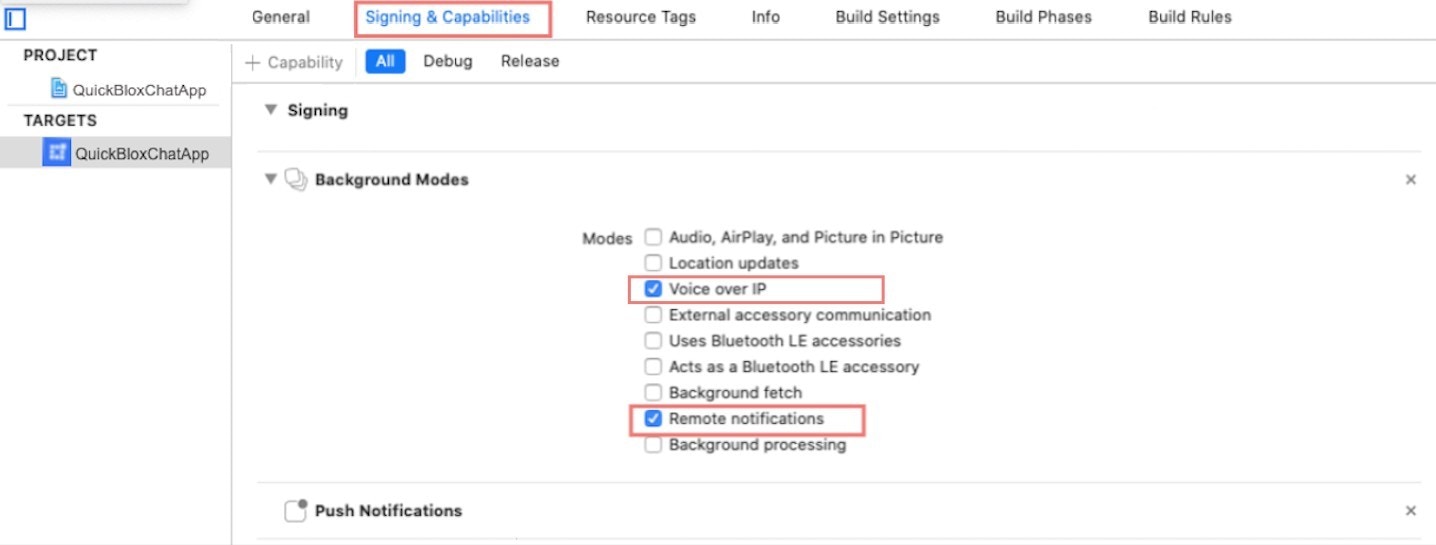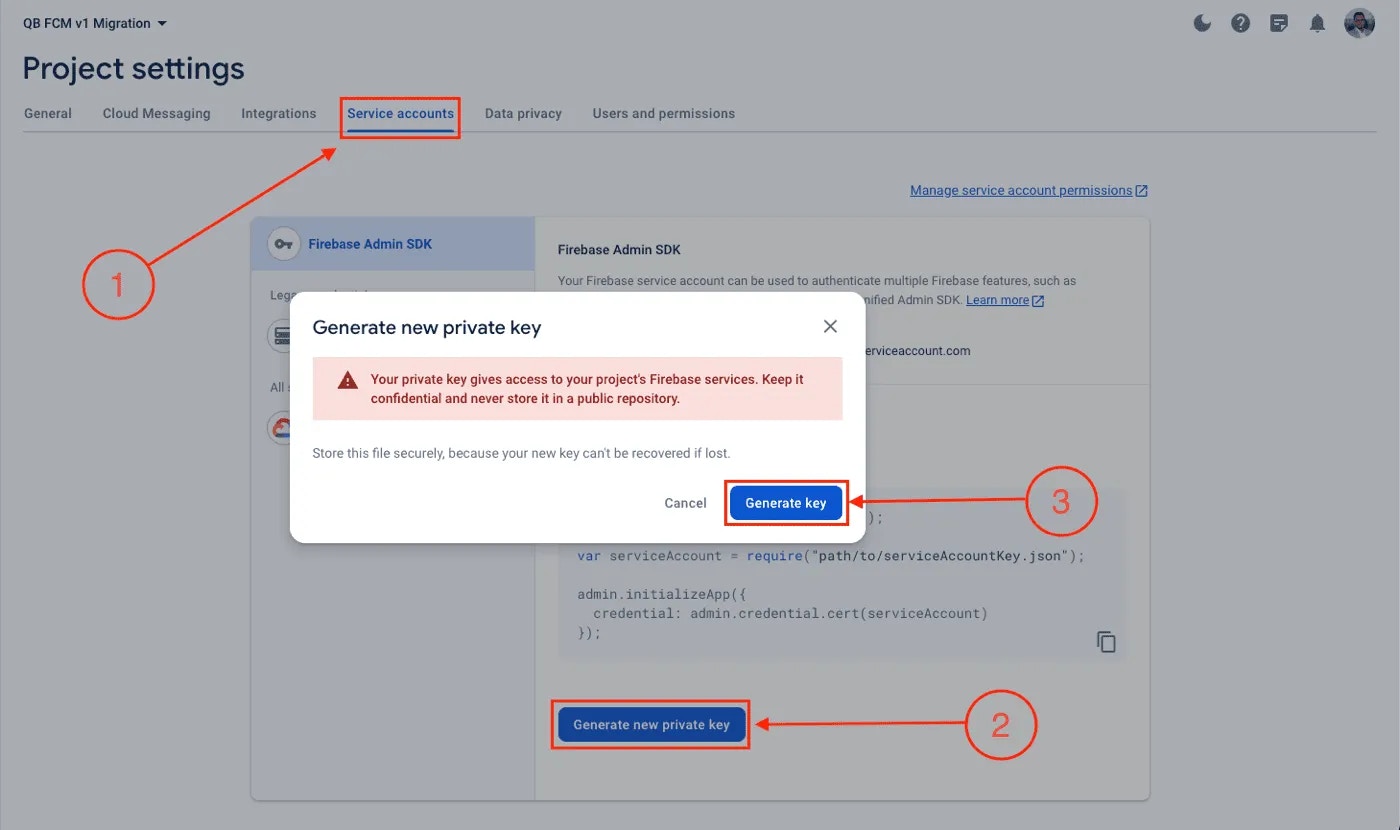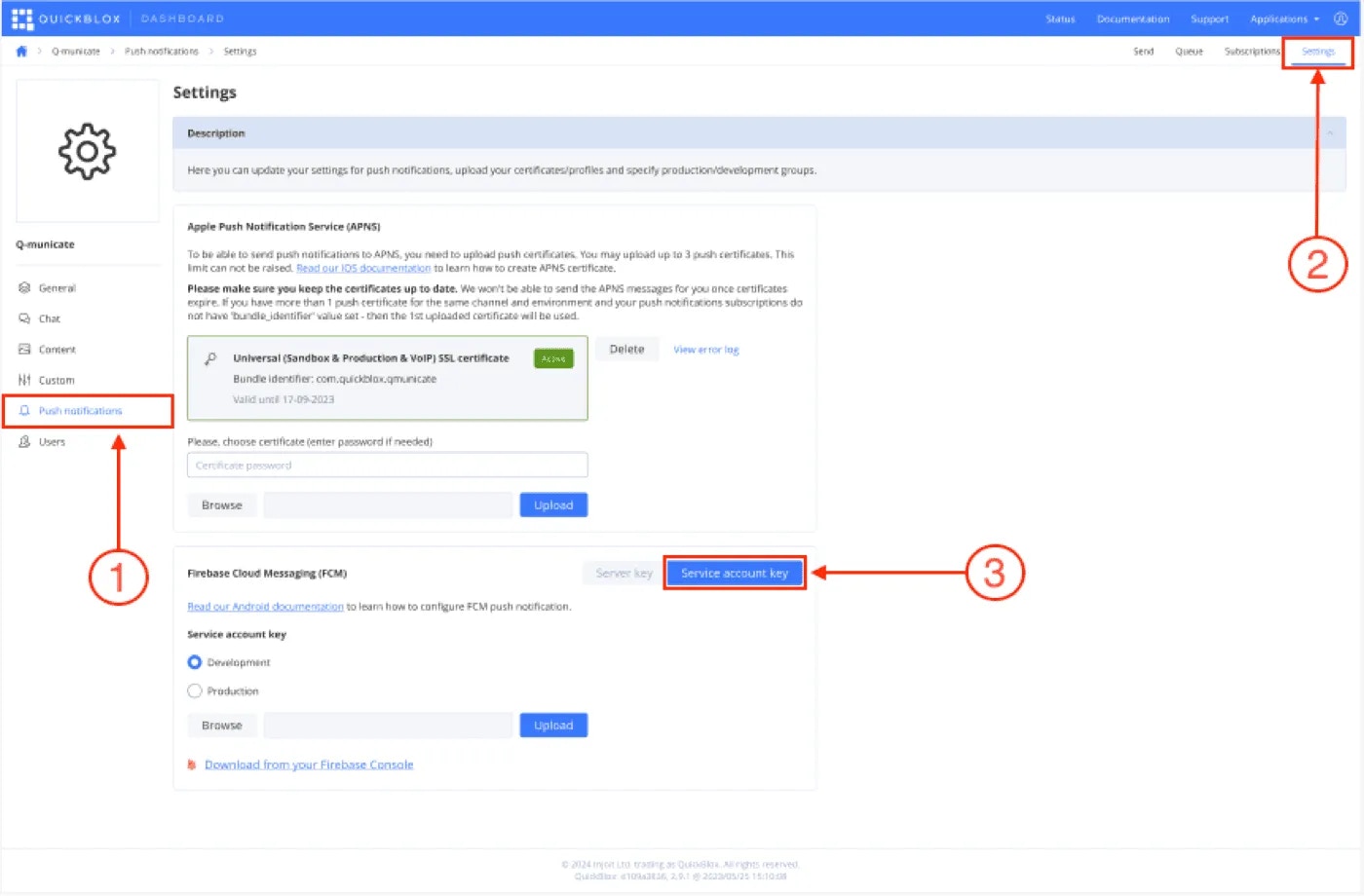- Offline messages. Send a chat message when a recipient is offline. In this case, a push notification will be sent automatically if the user is offline.
- Offline calls. Make a video/audio call with offline opponents. In this case, a push notification will be sent manually.
- Requests to contact list. Send requests to add a user to the contact list. In this case, a push notification will be sent manually).
- User tags. Send notifications to specific user groups defined by tags.
Before you begin
- Register a QuickBlox account. This is a matter of a few minutes and you will be able to use this account to build your apps.
- Configure QuickBlox SDK for your app. Check out Setup page for more details.
- Create a user session to be able to use QuickBlox functionality. See Authentication page to learn how to do it.
Configuration
iOS
Step 1. Create APNs certificate and upload it to the Dashboard. Each iOS application that uses Apple Push Notifications must have an APNs certificate. Upload the APNs certificate to QuickBlox Dashboard => Push Notifications => Settings => Apple Push Notification Service (APNs). To learn how to create APNs certificates and upload them to Dashboard, refer to the guide. Step 2. Open your project in Xcode and enable Push Notifications capabilities.- Open Xcode and choose your project file.
- Choose the Signing & Capabilities tab.
- Add a Push Notifications and Background Modes capabilities. To see these sections, you should be logged in to Xcode with your Apple ID that is enrolled in the Apple developer program.
- Turn on a Push Notifications capability.
- Turn on a Background modes capability. This section requires you to add specific app permissions.
- Select a Remote notifications checkbox if you want to receive push notifications when the app goes to background mode.
- Select a Voice over IP checkbox if you want your app to receive incoming Voice-over-IP (VoIP) push notifications and use them to display the system call interface to the user when the app is in the background mode.

Android
Step 1. Configure Firebase project and get API key and Sender ID. First, you should create a Firebase account if you haven’t it. Then you should configure your Firebase project. Register a QuickBlox account. This is a matter of a few minutes and you will be able to use this account to build your apps. Configure QuickBlox SDK for your app. Check out Setup page for more details. Create a user session to be able to use QuickBlox functionality. See Authentication page to learn how to do it. Step 2. Generate a new service account key.
- Open the Firebase console and select your project.
- Go to Project settings > Service Accounts.
- Click on Generate new private key and confirm by clicking Generate key.
- Securely store the JSON file containing the private key that will be downloaded

- Head over to QuickBlox dashboard, and choose your application.
- Select the push notifications tab and navigate to the settings page.
- Select the Service account key tab
We will remove the Server key tab when it will be discontinued by FCM, you will by default only have the service account key section on the dashboard.

- Choose the environment for your service account key. (Development/Production)
- Click on the Browse button and select the JSON file containing the key that was downloaded in Step 2.
- Hit the Upload button.
When setting up your environment, it’s important to distinguish between development and production modes. If you’ve uploaded a development certificate, it will only function for subscriptions created in the development environment, and likewise for production. This separation ensures seamless testing and deployment of push notifications across different environments.
- As part of enabling Firebase services in your Android application, you need to add the google-services dependency to your project-level
build.gradlefile.
groovy
- Add FCM dependency to your app level
build.gradlefile.
groovy
- Include a gms plugin to your app level
build.gradlefile.
groovy
- Download the
google-services.jsonfile from your Firebase Project dashboard and put it into your app folder in your Android project.
Subscribe to push notifications
We recommended using the library firebase_messaging (link: https://pub.dev/packages/firebase_messaging) to receive/send the push notifications. Subscribe for push notifications. Create a push subscription using the code below.Dart
The
deviceToken is a device registration token generated by the APNs or GCM/FCM. The token can be unregistered by the APNs or GCM/FCM anytime. In this case, the device should be registered again and obtain a new token. When a new token is obtained, a new subscription should be created.Send push notifications
We recommended using the library firebase_messaging (link: https://pub.dev/packages/firebase_messaging) to receive/send the push notifications. You can manually initiate sending push notifications to user/users on any event in your application. To do so, you need to form push notification parameters (payload) and set the push recipients.Dart
| Argument | Required | Description |
|---|---|---|
| eventType | yes | Types of the notification event:- QBNotificationEventTypes.ONE_SHOT - a one-time event (valid only if the date is not specified).- QBNotificationEventTypes.FIXED_DATE - a one-time event that occurs at a specified date (valid only if the date is specified).- QBNotificationEventTypes.PERIOD_DATE - is a reusable event that occurs within a given period from the initial date (valid only if the period is specified). |
| notificationEventType | yes | Type of notifications:- QBNotificationTypes.PUSH - send push notification.- QBNotificationTypes.EMAIL - send email. |
| senderId | yes | ID of the user who created the event. |
| payload | yes | Push notification payload. Can contain a message (string) property and many other key-value pairs (string-string). Refer here for more details. |
| pushType | no | Channel for delivering notification. Used only if the notification type is QBNotificationTypes.PUSH, ignored in other cases. If a QBNotificationPushTypes is not present, the notification will be delivered to all possible devices/platforms for specified users. Possible values are:QBNotificationPushTypes.APNSQBNotificationPushTypes.APNS_VOIPQBNotificationPushTypes.GCMQBNotificationPushTypes.MPNS |
You can send APNs VoIP notifications to the iOS app. However, if the iOS app is not subscribed to APNs VoIP notifications or the APNs VoIP certificate has expired, the regular APNs will be delivered instead of APNs VoIP.
Recieve push notifications
To receive the push notifications, we recommend using this library. To show notifications on the screen, we recommended using this library.Dart
Make sure that the application has a correct icon file for notification.
Unsubscribe from push notifications
To delete a subscription, use the following code snippet.Dart
Troubleshooting
A subscription is removed after a push is sent and the push isn’t delivered
Cause: a device registration token is invalid.The device registration token is represented as
deviceToken within the system and is set in the subscription. See this section to learn how to subscribe a device to push notifications.- Some other data is set instead of a correct device registration token. For example, a Firebase project ID, Firebase user token, etc.
- The client app unregistered itself from GCM/FCM. This can happen if the user uninstalls the application or, on iOS, if the APNs Feedback Service reported the APNs token as invalid.
- The registration token expired. For example, Google might decide to refresh registration tokens or the APNs token may have expired for iOS devices.
- The client app was updated, but the new version is not configured to receive messages.